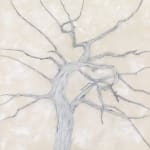
Tony Bevan British, b. 1951
Epistrophy Grey White (PC2213), 2022
Acrylic and charcoal on canvas
164.5 x 162 cm. (64 3/4 x 63 3/4 in.)
Copyright The Artist
Further images
Tony Bevan’s Epistrophy series focuses on the repeated depiction of a single leafless tree located near his studio in Sussex. The tree is painted from memory rather than direct observation....
Tony Bevan’s Epistrophy series focuses on the repeated depiction of a single leafless tree located near his studio in Sussex. The tree is painted from memory rather than direct observation. The title of the series, Epistrophy, is taken from a jazz composition by Thelonious Monk. In rhetorical terms, “epistrophe” refers to the repetition of a phrase at the end of a clause or sentence. Bevan uses this idea to reflect the repetitive nature of the tree motif in his work – each painting revisits the same subject but varies in form, colour, and mood.
The tree is rendered using Bevan’s typical materials: hand-ground pigments mixed with a clear acrylic medium and applied on raw, unsized linen. He lays the canvas flat on the studio floor, first drawing with charcoal and then applying pigment using brushes and his hands. The rapid drying of acrylic forces Bevan to work quickly. As a result, the surface often includes loose clumps of pigment and visible patches of bare canvas, creating a dry, textured finish.
Visually, the tree is reduced to a network of slender branches that spread across the canvas like veins or nerves. The structure appears fragile but deliberate, consistent with Bevan’s ongoing interest in anatomical and skeletal forms. While his earlier work often focused on human heads and torsos, the Epistrophy series shifts this attention to a natural subject that is treated in much the same way – stripped back, linear, and emphasising internal structure.
Each version of the tree is slightly different, reflecting changes in memory, season, and mood. Some versions are darker and more densely worked, while others are paler and more open in composition. Despite the repetition, no two paintings in the series are identical.
Bevan’s Epistrophy series continues his broader exploration of structure, repetition, and the tension between observation and memory. By painting the same tree multiple times, he transforms it from a specific location into a recurring visual form that holds psychological and symbolic weight.
The tree is rendered using Bevan’s typical materials: hand-ground pigments mixed with a clear acrylic medium and applied on raw, unsized linen. He lays the canvas flat on the studio floor, first drawing with charcoal and then applying pigment using brushes and his hands. The rapid drying of acrylic forces Bevan to work quickly. As a result, the surface often includes loose clumps of pigment and visible patches of bare canvas, creating a dry, textured finish.
Visually, the tree is reduced to a network of slender branches that spread across the canvas like veins or nerves. The structure appears fragile but deliberate, consistent with Bevan’s ongoing interest in anatomical and skeletal forms. While his earlier work often focused on human heads and torsos, the Epistrophy series shifts this attention to a natural subject that is treated in much the same way – stripped back, linear, and emphasising internal structure.
Each version of the tree is slightly different, reflecting changes in memory, season, and mood. Some versions are darker and more densely worked, while others are paler and more open in composition. Despite the repetition, no two paintings in the series are identical.
Bevan’s Epistrophy series continues his broader exploration of structure, repetition, and the tension between observation and memory. By painting the same tree multiple times, he transforms it from a specific location into a recurring visual form that holds psychological and symbolic weight.
